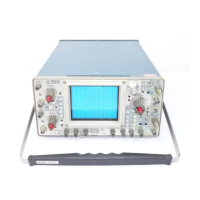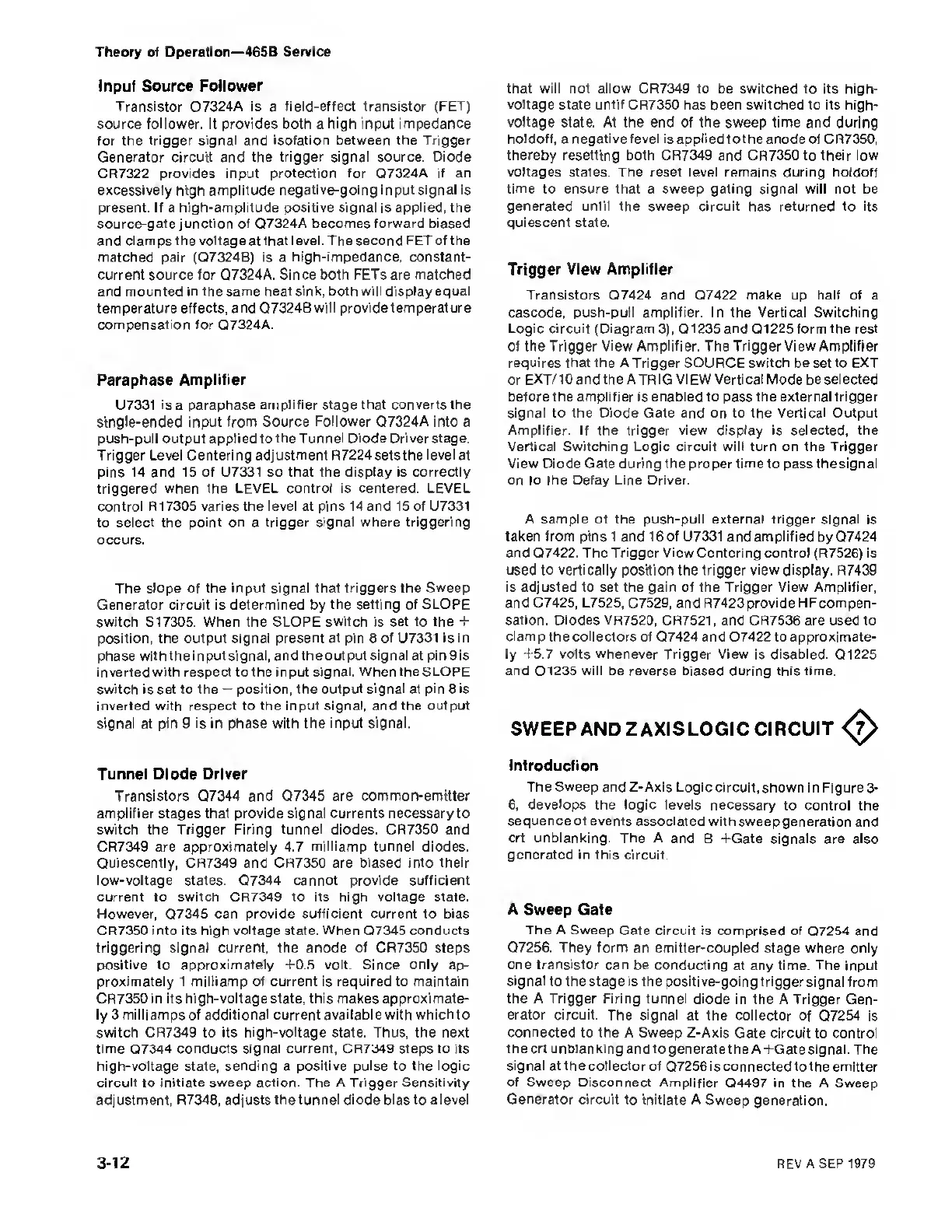Theory of Operation—465B
Service
Input Source Follower
Transistor
Q7324A is
a
field-effect
transistor
(FET)
source follower. It provides both a
high
input impedance
for the trigger signal and
isolation
between the
Trigger
Generator circuit and the trigger
signal
source.
Diode
CR7322
provides input protection for Q7324A if an
excessively high amplitude negative-going input signal is
present.
If
a
high-amplitude positive signal
is
applied, the
source-gate junction of
Q7324A becomes
forward
biased
and clamps the voltage at that
level. The
second
FET of the
matched pair (Q7324B)
is
a
high-impedance, constant-
current source for Q7324A. Since both FETs are matched
and mounted in the same heat sink, both will display
equal
temperature effects, and Q7324Bwill providetemperature
compensation for Q7324A.
Paraphase Amplifier
U7331
is
a
paraphase amplifier stage that
converts
the
single-ended
input
from Source Follower Q7324A into a
push-pull output applied to the Tunnel Diode Driver stage.
Trigger Level Centering adjustment R7224 sets the
level
at
pins 14 and 15 of U7331 so
that
the
display is correctly
triggered when the
LEVEL control is centered. LEVEL
control R 17305
varies the level at pins 14 and 15 of U7331
to select the point on a trigger
signal
where
triggering
occurs.
The
slope
of
the input signal
that
triggers
the
Sweep
Generator circuit is determined by the setting of SLOPE
switch
S17305.
When the SLOPE switch
is
set to the
+
position, the
output signal present at pin 8 of U7331 is
in
phase with the input signal,
and
the
out put signal at pin 9 is
inverted
with respect to the input signal. When the SLOPE
switch is
set
to
the
—
position, the output signal at
pin
8 is
inverted with respect to the input signal, and the output
signal at
pin 9 is in phase with the
input signal.
Tunnel Diode
Driver
Transistors Q7344
and
Q7345 are common-emitter
amplifier stages that
provide signal currents necessary to
switch the Trigger Firing tunnel diodes. CR7350 and
CR7349 are
approximately 4.7 milliamp tunnel diodes.
Quiescently, CR7349 and CR7350 are biased into
their
low-voltage states. Q7344
cannot
provide
sufficient
current to switch
CR7349
to its high voltage state.
Flowever, Q7345
can
provide sufficient current to bias
CR7350
into
its high
voltage state. When Q7345 conducts
triggering signal
current,
the anode
of
CR7350 steps
positive to approximately +0.5 volt. Since only ap-
proximately 1 milliamp
of
current is required to maintain
CR7350 in
its high-voltage state, this makes approximate-
ly 3 milliamps of
additional current available with whichto
switch
CR7349
to its high-voltage state. Thus, the next
time Q7344 conducts
signal
current, CR7349 steps to its
high-voltage state, sending a positive pulse to the logic
circuit
to
initiate sweep action. The A Trigger Sensitivity
adjustment, R7348, adjusts
the tunnel
diode
bias to
a
level
that will not allow
CR7349 to be switched to its high-
voltage state until
CR7350
has
been switched to its high-
voltage state. At the end of the sweep time and during
holdoff, a negative level is applied to the anode of CB7350,
thereby resetting both
CR7349 and CR7350 to their low
voltages
states.
The
reset level remains during
holdoff
time to ensure that
a
sweep gating signal will not
be
generated
until the sweep circuit has returned to its
quiescent state.
Trigger View Amplifier
Transistors Q7424 and Q7422 make up half of
a
cascode, push-pull amplifier. In the Vertical Switching
Logic circuit (Diagram
3),
Q1235and Q1225 form the rest
of the Trigger View Amplifier. The Trigger View Amplifier
requires
that the A Trigger SOURCE switch be set to EXT
or
EXT/10 and
the
A TRIG VIEW Vertical Mode
be
selected
before
the amplifier is enabled
to pass the
external
trigger
signal
to
the
Diode Gate and on to the
Vertical Output
Amplifier. If the
trigger
view display is selected, the
Vertical Switching Logic circuit will turn
on
the Trigger
View Diode Gate during the proper time to passthesignal
on to the Delay Line Driver.
A sample of the push-pull external
trigger
signal
is
taken from pins
1
and 16
of U7331 and amplified byQ7424
and Q7422. The Trigger View Centering control
(R7526)
is
used to
vertically
position the trigger view display. R7439
is adjusted to
set
the gain of the Trigger View Amplifier,
and C7425, L7525, C7529, and R7423 provide HF compen-
sation. Diodes VR7520, CR7521, and CR7536 are used to
clamp the collectors of Q7424
and
Q7422 to approximate-
ly
+5.7 volts whenever Trigger
View is disabled. Q1225
and Q1235 will
be reverse biased during this time.
SWEEP AND
Z
AXIS LOGIC CIRCUIT
^
Introduction
The Sweep
and Z-Axis Logic circuit, shown
in Figure
3-
6,
develops the logic
levels necessary to control the
sequence
of events associated with sweep
generation and
ert unblanking. The A and B
+Gate signals are also
generated
in
this
circuit.
A Sweep Gate
The
A
Sweep Gate circuit is
comprised of Q7254 and
Q7256. They form
an emitter-coupled stage where only
one transistor can be conducting
at any
time.
The input
signal to the stage
is
the positive-going
trigger signal from
the A Trigger Firing tunnel
diode in the A Trigger
Gen-
erator circuit. The signal at the collector
of Q7254 is
connected to the A
Sweep Z-Axis Gate circuit
to
control
the ert
unblanking and to generate the
A +Gate signal. The
signal
at the collector of
Q7256
is
connected tothe emitter
of Sweep Disconnect
Amplifier Q4497
in the
A
Sweep
Generator circuit
to initiate
A
Sweep generation.
3-12
REV A
SEP 1979

